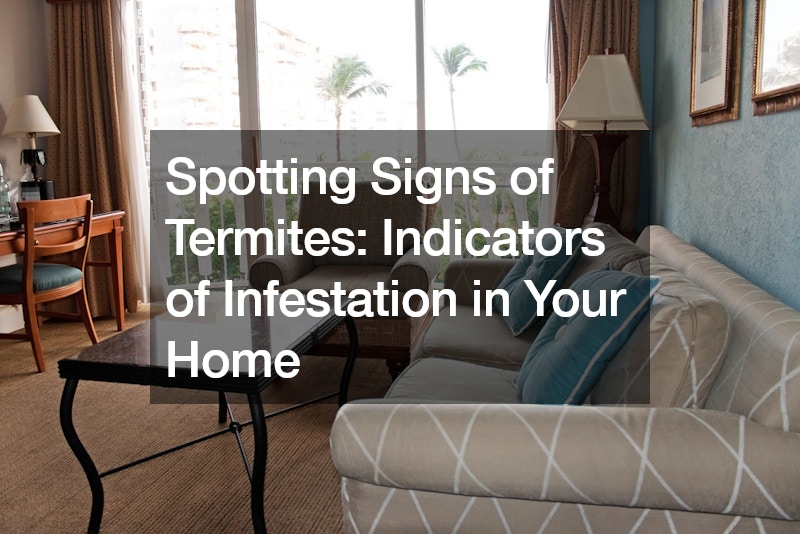

Termites, commonly known as “silent destroyers,” have the potential to cause significant damage to your home without detection. These small insects feed on wooden structures, resulting in billions of dollars in annual damages across the United States. Identifying termite infestations early is essential for reducing damage and avoiding expensive repairs. This article will delve into 12 signs that may indicate a termite infestation in your home, along with additional pertinent topics to enhance your understanding and management of this potential threat.
- Head Banging: One subtle sign of termites is the quiet clicking sounds they produce. If you listen closely, you might hear them munching away on wood.
Additionally, termite soldiers bang their heads against wood or shake their bodies to signal danger to other termites within the colony.
- Flying Termites: Swarms of flying termites, also known as swarmers or alates, are often the first indication of a termite infestation. These winged insects leave their nest to find a mate and establish new colonies. Watch for discarded wings, as flying termites shed them shortly after mating.
- White Ants: Despite common misconceptions, there’s no such thing as a white ant. Termites are often mistaken for ants due to their similar appearance. However, termites are lighter in color, have straight antennae, and a thicker waist section compared to ants.
- Papery or Hollow Sound: When tapping on an area affected by termites, you may notice a hollow or papery sound. This indicates that the termites have consumed the wood from the inside out, leaving only a thin veneer or paint.
- Tight Fitting Doors and Hard-to-Open Windows: Warped doors and stiff windows could be a result of termite activity. The moisture produced by termites as they tunnel through wooden door and window frames can cause the wood to warp, making it difficult to open doors and windows.
- Tunnels in Wood: Termite tunnels, also known as galleries, are difficult to spot from the outside. However, if you come across broken timber with visible tunnels, it’s a clear sign of a termite infestation.
- Frass-Termite Droppings: Termite droppings, known as frass, are another indicator of an infestation. Drywood termites push out their feces from small holes near their nest entrances, leaving behind small black marks and a dark powdery substance.
- The Power Fails: While termites primarily feed on wood, they can also damage underground telephone wires, power wires, and cables. If you experience frequent short circuits without an apparent cause, termites might be to blame.
- Damaged Floors, Walls, or Ceiling: Termites can feed on a variety of wooden structures, including floors, walls, and ceilings. Look out for sags, blisters, cracks, or other signs of damage that could indicate a termite infestation.
- Damaged Foundation: Although most modern foundations are made of concrete, termites can still gain access to wooden floor joists through small cracks. Homes with cracked foundations are at a higher risk of termite infestation.
- Damaged Roof Tiles: Loose or broken roof tiles can lead to moisture buildup, attracting termites to your home. Once inside, they can cause significant damage to wooden surfaces.
- Your Garden Is Damaged: Termite infestations may start in your garden, where they can feed on timber decking, wooden fences, and trees. Keep an eye out for signs of damage in your garden, as it could indicate a potential termite problem in your home.
Taking Action: The Importance of Professional Termite Control
If you suspect a termite infestation in your home, based on the signs outlined above, it’s crucial to take immediate action. Ignoring a termite problem will only allow the infestation to worsen, leading to more extensive damage and higher repair costs. Here’s what to do:
- Schedule a professional termite inspection: A qualified termite control professional can thoroughly inspect your home to identify the type of termite infestation, determine the extent of the damage, and recommend the most appropriate course of treatment. They possess the expertise and tools to locate hidden termite colonies and assess the severity of the problem.
- Treatment options: Depending on the type and severity of the infestation, various termite control methods may be recommended. These can include:
- Liquid termite treatments: A barrier of insecticide is applied around the foundation of your home to deter termites from entering.
Termite bait stations: These stations contain a slow-acting bait that attracts and eliminates termites. - Fumigation: In severe cases, fumigation may be necessary to eradicate the entire termite colony.
- Preventative measures: Once a termite infestation has been addressed, it’s vital to implement preventative measures to minimize the risk of future problems. Here are some key steps:
- Moisture control: Address any moisture issues around your foundation and throughout your home, as termites thrive in damp environments.
- Regular inspections: Schedule annual termite inspections to detect any early signs of activity before they become a major issue.
- Maintain your property: Address cracks in your foundation, seal gaps around pipes and wires entering your home, and eliminate any sources of wood debris near your foundation.
Peace of Mind: Protecting Your Investment
By familiarizing yourself with the signs of a termite infestation and taking proactive steps, you can safeguard your home from these destructive pests. Early detection and prompt action are key to minimizing damage and preventing costly repairs. Don’t hesitate to seek professional termite control assistance if you suspect any termite activity in your home. A proactive approach ensures the longevity and structural integrity of your property, offering you peace of mind and protecting your valuable investment.
.



